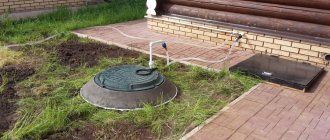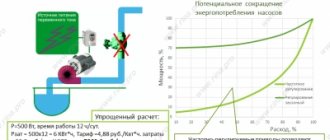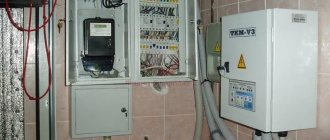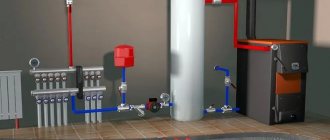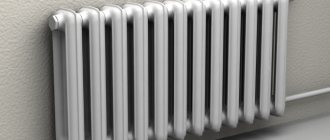Heating is one of the most important communications in an apartment. This system is necessary for heating the home during the cold season.
Previously, apartments were heated using a central heating system (CHS). But today many are switching to “autonomy”.
Read more about how to make individual heating in an apartment building further in the article.
Why do residents refuse central heating?
There are a number of reasons for this:
- unjustified heating costs;
- poor-quality heating of the apartment during the cold period;
- improper heat distribution (especially for corner apartments and rooms located on the ground floor);
- dependence on the established timing of the heating season (cold in autumn and hot in spring);
- inability to maintain the desired temperature at any time.
Judging by the reviews, those who abandoned the central heating system and spent money on installing a “autonomous system” quickly return the invested funds, saving on utility bills.
Pros and cons of individual heating
The advantages of autonomous heating are obvious:
- Significant savings. According to reviews from residents who have switched to “autonomy”, heating costs are reduced by 5–7 times.
- Ability to regulate the air temperature in the apartment. Some heating systems allow you to set the required mode, in which the intensity of heating the room changes at programmed intervals. For example, in the first half of the day, when all family members are at work or school, the temperature drops, and in the evening it rises again. This mode also leads to cost savings.
- Hot water supply.
- Possibility of choosing radiators. Any batteries are suitable for an autonomous system, since in this case there is no possibility of water hammer.
The disadvantages of an individual heating system are as follows:
- High cost of equipment and system elements.
- Dependence of the latest boiler models on power supply.
- The need to install a new heating circuit.
- In many cases, it is necessary to install a suitable exhaust duct.
Sewerage
The following elements of the sewage system are located in the basement:
- Risers with revisions for cleaning;
Sewer riser
- Lezhnevki are horizontal branches that collect the drains of several risers and transport them to the outlets of the wells. Straight sections of the bedstead are equipped with oblique tees or revisions every 12-15 meters;
- Outlets to wells with tees for cleaning.
Blocked riser
Symptoms: drains from upper apartments enter the apartment on the lower floor through the toilet, bathtub and sinks (if the sinks are not tightly connected to the sewer, through the sockets of the latter).
Clogged riser: all the drains from the neighbors above enter the apartment
- Fat deposits at the connection of the riser with the bed, or in the bed itself;
- Silting of the litter box or accumulation of sand, cat litter, etc.;
- Foreign objects entering the sewer system (rags, bottles thrown into the ventilation outlet on the roof, large food waste, construction waste).
Solution: cleaning the riser and bed with a cable or wire through the inspection. After cleaning the grease plug, the bed should be rinsed with plenty of hot water.
Clearing clogged drains
Clogged bed
Symptoms: sewage floods several apartments on the lower floors. As an option, the wastewater enters the basement through the open socket of the tee on the bench.
The basement is flooded with sewage
The causes and solution to the problem in this case are identical to those described above. A caveat: if possible, the blockage should be cleared through the inspection located above it along the drain. Otherwise, at the time of cleaning, you may be doused with sewage: they will begin to flow to the opened inspection with a pressure of 2-3 meters.
Clogged outlet to the well
Symptoms: wastewater does not flow into the yard sewer well, flooding the apartments or basement.
Solution: cleaning the outlet through the tee in the basement.
Tee before release
You can clean the outlet from the well side only by feeding wire to the blockage from the surface, through an L-shaped pipe with a diameter of 32-40 mm. There are two reasons for this:
- When the blockage is cleared, the wastewater will flow into the well with a pressure of several meters. It is very difficult to dodge the fetid stream in a confined space;
- Methane often accumulates in yard sewer wells. It is not toxic in itself, but it displaces breathable air. Loss of consciousness due to oxygen deficiency at a well depth of 2 meters or more means certain death.
- Caulking the socket of a cast iron sewer;
Leaking caulked socket
- Destruction of the bell;
- Destruction of a section of a riser or bed.
- A socket joint that does not have mechanical damage is sealed (embossed) with a heel or graphite gland;
- The destroyed bell is cut out with a grinder and replaced with an assembly of a coupling and a compensating pipe;
- Any straight section of the sewer system can be repaired using the same method.
Sewerage repair using a compensating pipe
How to switch to individual heating?
In order to understand how to switch an apartment to individual heating, you need to know the legal norms.
The installation procedure is regulated by several regulations, namely:
- Federal Law No. 190 “On Heat Supply”;
- Art. 26-27 Housing Code of the Russian Federation;
- Government Decree No. 307.
To transfer an apartment to individual heating in an apartment building you need:
- Submit an application for waiver of the CSO.
- Obtain the consent of various structures for this.
- Submit an application to the district electrical network office for the installation of individual heating in the apartment.
To install autonomous heating in an apartment, it is necessary to obtain the consent of local authorities, residents of the entire building, gas workers, and architects.
What must be observed during the transition?
The legislation imposes the following requirements for the premises where autonomous heating will be installed:
- Room area: from 4 m² with a ceiling height of 2.5 m.
- Door width: at least 80 cm.
- The room must have at least one window.
- Do not place a gas stove or heating appliances close to the boiler. A distance of at least 30 cm must be maintained between them.
- The boiler is installed on a load-bearing wall at least 1.5 m from the floor.
If individual heating is installed in an apartment with your own hands, then you need to strictly follow the instructions included with the boiler. But only gas service workers should connect the boiler.
Installation procedure for autonomous heating
So, how to make individual heating in an apartment? First, you need to get a waiver from the CSO. Then you need to collect a package of documents on the reconstruction of living space, containing:
- application for reorganization;
- technical certificate of the premises;
- title documents for housing;
- residential refurbishment project;
- written consent of all family members;
- conclusion of the authorities for the protection of architectural monuments on the possibility of reconstructing the premises.
After reviewing the application, the Management Company will issue written permission to disconnect the apartment from the CSO . This permit will serve as the basis for ordering technical conditions for the installation of individual heating.
If you plan to install a gas boiler, your request should be addressed to the gas service. Technical specifications are issued within 10 days.
Refusal is possible only in non-gasified regions, as well as where it is not possible to purchase gas in cylinders.
Next, purchase a certified boiler and contact a design organization in order to develop a project for installing the boiler, taking into account technical conditions and capabilities.
Then a project is carried out to disconnect from the central heating system at the heat supply organization . The basis for this will also be written permission from the HOA to disconnect the apartment from the central heating. It is important to receive a written response.
With the project documentation, go to the local branch of the All-Russian Voluntary Fire Society (VDPO), where you will receive a fire safety report for the project. If necessary, make a design for the chimney.
All this documentation is approved by the administration, where within 45 days they must issue a conclusion on approval (or refusal) of the reconstruction of the premises. The refusal can be appealed in court.
Is it possible to do the installation yourself?
In order not to hire specialists, but to do the installation yourself, you need to know how individual heating works. But even after studying all the nuances, such actions as installing the boiler and auxiliary equipment, connecting gas and laying risers should be carried out by specialists from the relevant services. But everyone can install radiators. The main thing is to check the tightness before using the system. Leaks are usually detected at the junctions of radiator sections or pipes and radiators. A reliable way to check for leaks is to let coolant into the system. You must be prepared to immediately fix the leak so as not to flood your neighbors.
How to calculate a heating system?
In order to maintain a comfortable temperature in the apartment, it is necessary to properly install the heating system . To do this, you need to make accurate calculations. It all depends on the area of the room (S) and the power of the gas boiler (W) per 10 m². It is also worth considering the climatic features of the region.
The power of the heating boiler is calculated using the formula: boiler = SW beat. / 10. This simple calculation will help you choose the boiler needed for your apartment.
Heating calculations also depend on the type of heating system. The most optimal option for an apartment is a two-pipe system . It is more expensive and more complex than a single-pipe one, but the heating quality will be higher. All batteries will heat up evenly. A single-pipe system is suitable only for a small number of radiators.
Installation process
Installation work to install the heating system is carried out in accordance with technological requirements and is carried out in several stages. Failure to comply with clear rules and requirements can cause incorrect operation of the equipment and lead to an emergency.
Marking
First of all, markings are applied in places where pipes will pass and radiators will be installed.
In order for the elements of the highway to be at the same level, as required by the technology, marks are placed using a level.
Radiator installation
At the next stage, the batteries are attached to their seats. To do this, holes for fasteners are drilled at the marked points with a hammer drill, which need to be secured with dowels.
Radiators are hung on the installed fasteners, and fittings are screwed to them.
Pipe laying
Then they begin to pull the pipes. Their assembly begins from the beginning of the wiring and, accordingly, the return. Using a soldering iron, fittings are welded to the edges of the pipes that will connect the line to the heating boiler. The soldering process consists of stripping the edges of the pipes from foil and inserting them into the nozzle of a heated soldering iron; in parallel, the fitting is heated in the same way to the desired temperature (usually 260 °C).
Next, the parts are joined with hot edges in a straight line and pressed tightly - this forms a homogeneous permanent connection. Similarly, the edges of the contour parts are connected along the entire perimeter of the apartment. To avoid deformation of the pipes, they are fixed to the wall with fasteners every 65–70 cm.
At the junction of radiators with plastic elements of the heating system, corner valves are welded. The system is ready for connection to a gas boiler, the installation and connection of which is best left to qualified specialists due to the complexity of the work and increased safety measures for its implementation.
How to choose a boiler?
Having decided on the power of the boiler, proceed to choosing its type . The boiler can be single-circuit (i.e., intended only for heating) or double-circuit (in addition to heating, the boiler heats water).
Next you need to decide on the type of fuel. Boilers are single-fuel (gas boilers or electric boilers) and combined type, that is, they can operate on different types of fuel (for example, gas + electricity or gas + liquid fuel + electricity).
It is also worth considering when choosing a boiler - the material of manufacture; This factor affects the lifespan of the equipment. Boilers made of steel or cast iron are quite heavy and more difficult to install, but they last a long time.
A gas boiler
Autonomous gas heating is the most relevant today, since gas is considered the cheapest type of fuel.
A closed-type gas wall-mounted boiler with a combustion chamber, according to experts, is the best option for home heating today. It has a horizontal smoke exhaust system, due to which carbon monoxide escapes to the street.
Advantages of a gas boiler:
- silent operation;
- multi-level security system;
- maintaining the required temperature in the apartment, regardless of gas pressure;
- acceptable price.
Electric boiler
Electric heating can be the main or additional heating option. The system is easy to use, easy to install, and takes up little space.
Electric boilers can be wall-mounted or floor-mounted . Both options are effective, silent, and functional.
Electric heating is less in demand than gas heating, but in the future, perhaps, this type of fuel will become more relevant.
Selection of pipes and radiators
The most popular today are polypropylene pipes . Their operating temperature is no more than 95 °C, which is quite enough for the operation of gas and electric boilers. The number of pipes is determined by the wiring diagram. For a two-pipe system you will need more of them than for a one-pipe system.
As for batteries, the most suitable option for “autonomy” is sectional batteries . The length of the radiator is affected by the quality of heat transfer of one section, which depends on the material of manufacture. So, the steel section produces 85 watts of heat, cast iron - 110 watts, aluminum - from 175 to 199 watts, bimetallic - 199 watts.
To calculate the area that one section can heat with a ceiling height of 2.7 m, divide the heat transfer rate by 100.
For example, a cast iron section heats 1.1 m². The number of sections for the radiator is calculated depending on the size of the room.
Principle of operation
The principle of operation of a water heated floor system: a system of pipelines through which the coolant is supplied is laid in the screed. Warm pipelines heat the screed, the screed transfers heat to the floor covering, and the covering transfers heat to the room. The floor under the furniture is not heated.
Such a heating system creates a favorable temperature distribution over height and helps save the amount of heat consumed (and finances) compared to a radiator system. With a conventional heating scheme, warm air from the radiators rises to the ceiling, heats it, and only then heats the room - with the convection method, the energy loss for heating the ceiling, walls and windows (batteries are installed under them) is quite large.
It is especially effective to use lower heating in a house if there is second light or high ceilings - in this case, savings increase, according to some data, even up to 50%.
How much does it cost to install autonomous heating in 2022?
It is impossible to say exactly how much it will cost to switch to an individual heating system. It all depends on the cost of the material, on the tariffs for processing documents in the region. Still, most of the costs are the purchase of equipment and the work of specialists to install the system.
The most expensive part is the boiler. Gas units are cheaper than electric units and cost at least 10,000 rubles. The larger the area of the apartment, the more powerful (and therefore more expensive) the boiler will be required.
And if you take into account safety and durability when choosing, then such units (and they are usually imported) will cost several times more than domestically produced boilers.
The most popular bimetallic batteries today will cost about 400 rubles per section. The choice of pipes is now very large: you can choose expensive metal or reliable polypropylene pipes, which cost a little less. Various small parts will also be needed: taps, locking devices, etc.
In general, the transition to individual heating in Moscow will cost approximately 100-140 thousand rubles . The amount seems impressive, but in the future everything will more than pay off. And there’s no need to talk about comfort and convenience.
So, installing individual heating in an apartment has its own characteristics. The documentation and permitting part will take a lot of time and effort. And money, of course, will also be required. But, judging by the reviews, a well-installed “autonomy” is worth it.
Video: Autonomous heating of an apartment - pros and cons
Sample list of documents
Since installing your own heating system refers to the refurbishment of a residential premises, the list will include:
- an application drawn up in a special form;
- documents establishing the right to own housing: state registration certificate, deed of transfer of ownership, gift agreement, document confirming the right of inheritance (originals or copies certified by a notary);
- certified copies for each owner and a statement signed by all owners (if the apartment is in shared ownership);
- a copy of the technical passport of the premises;
- consent of family members of the tenant and residents of the apartment building, documented in the form of minutes of the meeting of apartment owners (if the area is municipal);
- conclusion of the body responsible for the protection of architectural monuments, historical or cultural heritage on the possibility of redevelopment (if the house is an architectural, cultural or historical value).
USEFUL INFORMATION: Allowed time for repairs in an apartment: how not to quarrel with neighbors
The most difficult thing will be to prepare and provide technical documentation. These include:
- redevelopment project for the installation of a gas boiler, including gasification of the premises and changes to the central heating system;
- a copy of the passport for the electric boiler, technical conditions, agreement confirming the permission of the maximum power, which exceeds the capabilities of the boiler (when choosing an electric heating device);
- Specifications for disconnecting the wiring in the apartment from the communal heating system;
- Specifications for ventilation;
- Specifications for supplying gas networks.
